#tropical algae
Explore tagged Tumblr posts
Text



#marine biology#marine life#phycology#limu haul#herbarium daily#herbarium#digital herbarium#dictyota#dictyota acutiloba#tropical algae#brown algae
29 notes
·
View notes
Text
apparently pjotv twt was being weird about book!Percy's eyes being green because they don't think the ocean can be green (???) so consider this a sequel to my Grace siblings eye colors post and here is some visual references of green water for all your Percy inspo needs:



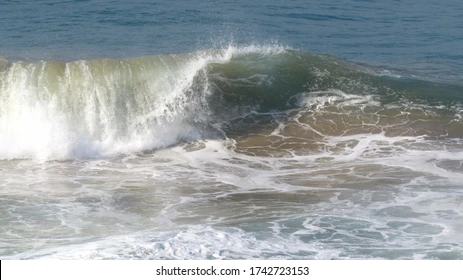
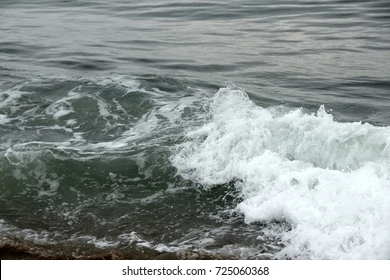

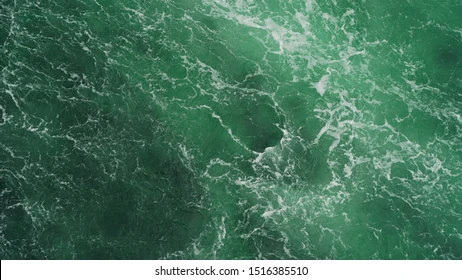



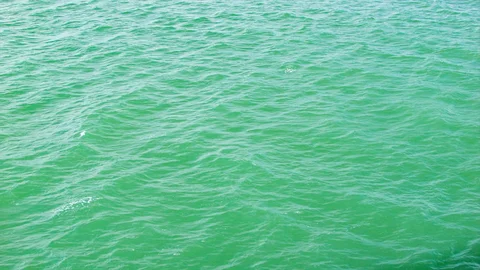
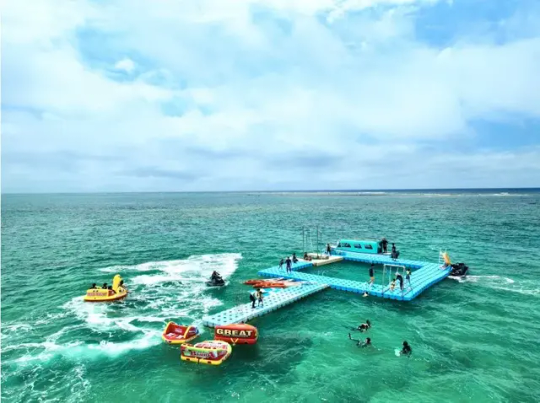
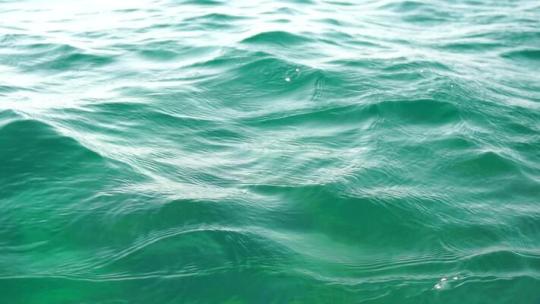





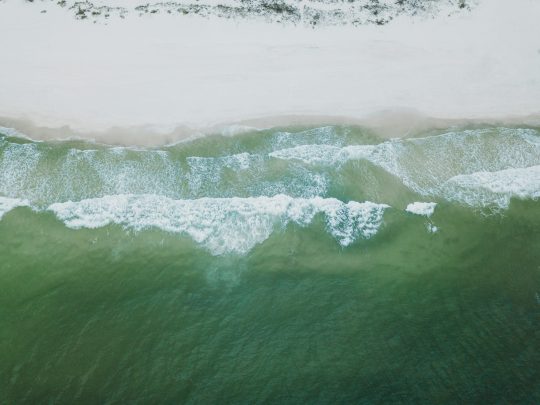
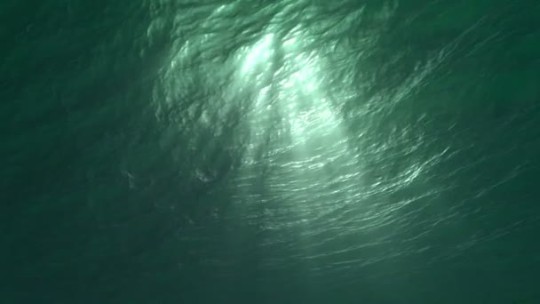
And for reference, the water around New York-ish where Percy is usually is somewhere around this color:

or some alternatives:

or here is a nice hazel green if you want his eyes more on the brown side, which is very common in freshwater ponds and streams:


or if you want him to have totally brown eyes - water rich in tannins will appear brown, greenish-brown, or very dark brown - this is sometimes called "blackwater" due to often appearing very dark or having low visibility:



#pjo#percy jackson#riordanverse#i am eternally amused by old pjo fandom's tendency to interpret ''sea-green'' as ''tropical seas / neon aqua''#mostly just cause as someone who grew up around boats when i think of ''sea-green'' i have a very particular color in mind#and its that kind of murky desaturated green#like sometimes ur at the docks and are just shoving your hand into low visibility green water to catch jellyfish yknow#thats the vibe. thats what i think of whenever i hear ''sea-green''#reach into your local harbor and you may find a friend and a boy (jellyfish)#and i respect not everybody is as familiar with the ocean but ''Percy's eyes being blue is *better* because the ocean is blue not green!''#is. just a ridiculous statement to me.#like. just. first and foremost. claiming blue eyes are ''better'' and the implications in that (bleugh)#secondly - claiming that ''the ocean isnt GREEN'' is just. well you're just wrong so jot that down#it is in fact not uncommon for the ocean to be green. this is very normal actually#the ocean not always being blue does not feel like particularly groundbreaking news????#like gonna be real my guy usually the ocean is actually pretty. idk. greyish.#especially if its not actively a very sunny day in the summer#cause a lot of the time if the water is just reflecting the sky and is not being particularly affected by whatever is actually in the water#then. well. the sky is usually greyish! on your average day the sky is usually kinda grey! it usually only gets really blue when its sunny#but usually water has. yknow. stuff in it. a lot of the time algae and such. so it ends up murkier/greenish#anyways this has been: AALV's oddly specific nitpicking about Percy's eye color
310 notes
·
View notes
Text
40 gallon long update~
Everything is going well in this tank apart from the odd bit of algae here and there.


The new pearl gourami is getting on nicely. Though it is a bit picky and will only eat flakes. He is quite shy and is still nervous when I come up to the tank. Hopefully, he will get used to me soon!

The bamboo shrimp is growing, too! I feed it some crushed up flakes and the powder from my rapashy.

The old dominant harlequin rasbora, who got his nose torn off in a fight, is doing well. He's eating fine, and there appears to be no infection going on. So I think he's okay.

Chiggy, my peppered corydoras that was born deformed, is doing good, too. She doesn't come out much, preferring to chill amongst the Val with the other corys.

Big Mama is still big. I'm still hoping she'll give me some eggs soon, but it's been a while since I've seen any breeding action from them.


The otocinclus and siamese algae eater are doing well, too! Doing their jobs and keeping the tank tidy~
#aquablr#fishblr#petblr#shrimpblr#pearl gourami#harlequin rasbora#glowlight rasbora#bamboo shrimp#peppered corydora#otocinclus#siamese algae eater#planted aquarium#aquarium#freshwater aquarium#fish#tropical fish
49 notes
·
View notes
Text

2 notes
·
View notes
Video
Sargassum Seaweed Bloom in the Caribbean Sea Aerial View by David Oppenheimer Via Flickr: Sargassum seaweed algae bloom in the Caribbean Sea high altitude aerial view - photo taken on February 5, 2018 - © 2018 David Oppenheimer - Performance Impressions aerial photography archives - www.performanceimpressions.com
#pollution#Caribbean Sea#Atlantic Ocean#blobs#sea#ocean#aerial#high altitude#sewage#altitude#Caribbean#tropical#Jamaica#Cuba#Sargassum Bloom#Sargassum#algae#marine#ecosystem#blue-green#Brown algae#seaweed#bloom#algae bloom#flickr
2 notes
·
View notes
Text
As a community, aquarists tend to become paranoid about 'hitch hikers', such as aiptasia (glass or triffid) anemones, and the entire clade of vermetid snails. As an online subculture, the community talks of these creatures as indestructible and existential threats, something more like fictional, movie xenomorphs, than what they are, real animals. Usually there exists a kernel of truth behind such fears, although aquarists folklore ignores the basic knowledge, that is relevant to their management - something more realist than a 'cure'. It seems strange today, but in the 1990s, any non-sedentaey polychaete could cause the majority of aquarists to panic. Of course the majority of them are harmless, and even helpful to the aquarist, because the common species are detrivores.
If the world of macroscopic plants has a counterpart in the 'reefer' imagination, it is surely that curious seaweed called bubble algae, or in other sorts of literature, sailor's eyeballs. We often call them all Valonia, and - with the caveat that I am not a botanist - I see no basis to doubt this. However the junior synonym Ventricaria is sometimes in use. These peculiar seaweeds - for they are unusual, green macroalgae - are all quite similar to one another, although some invest more energy in a larger 'bubble' - a spheroid to avoid body (or thallus), that is attached firmly to an underlying substrate - whilst others form a more creeping mat of smaller 'bubbles', because they may generate a stolon. It is the latter growth morphs that becomes invasive in our aquariums.
An curious and only half true bit of folklore about Valonia sp. is that they are the world's largest single celled organisms. Wether or not they are single celled is a matter of opinion, since they are miltinucleate, as are other green seaweeds of 'siphonous' type. Siphonous seaweeds are known to exist only among the green algae, with no counterparts among the brown or red algae, and to complicate things more, true multicellular algae have also evolved from non-siphonous, green algal ancestors. The 'giant cells' of siphonous algae contain numerous nuclei, each with its own 'cytoplasmic domain', whereas typical cells - of classically unicellular or multicellular organisms - possess but one cell nucleus. No cell wall separates the nuclei in the siphonous species, which is a basic difference from the truly multicellular plants.
Siphonous macroalgae thus exist outside of the familiar division of organisms into single or multiple cells, as we tend to take it for granted. For over one hundred years it has been pointed out, anyway, that the idea of a 'unicellular' organisms is flawed, on both semantic and empirical grounds. To begin with an organisms without cell walls is undivided, and therefore it cannot contain cells; also the 'cells' of what we call 'unicellular life' do not function entirely like the cells which act as the mere compartments of larger, living entities.
It is a frustrating description, but it is one that has stuck, and siphonous algae - and similarly multinucleate organisms, such as the famous slime molds -are clumsily expressed as 'giant cells'. If we view them as unicellular, then they surely are the biggest 'single celled organisms' in the world, but it is not the bubble algae would hold that title. Much larger siphonous macroalgae exist - such as Caulerpa sp and Halimeda sp. - that would wear that particular crown, sharing as they do the same siphonous nature as Valonia, and yet growing much, much larger.
Some people think that crabs which eat Valonia actively spread or, by releasing it's spores which are stored inside the globular thallus. This is nonsense because no spores are inside the plant, due to its structure making this impossible. This is not how the bubble algae multiply, although any intact 'cytoplasmic domain' can regenerate to form a complete Valonia organism. This is true of other siphonous algae such as Caulerpa, and neither makes bubble algae unique nor invincible. Without interference the bubbles multiply through division, which is also normal for such 'giant cells'. They also release new individuals via pores on their cell wall, and Valonia actually resembles, in its organization, the reproductive organs of some other siphonous algae
Incidentally the Mithrax group of crabs, including the emerald crab, M. sculptus, effectively consume Valonia; the problem is, their diets are broader than algae alone, and they are opportunistic foragers of sessile animals such as corals, and even slow, motile prey, such as snails. The popular focus on the emerald crab as a control agent of Valonia, is because few other herbivores find them palatable. In the wild they seem to be held in check by other, competing algae, and Valonia is commonest where these competitors are relatively absent. Some of the saccoglossan snails may be found on bubble algae, but most saccoglossan species will not consume it.
This is not to say that no other animals eat Valonia, but their extracts are known to be unappetising to herbivorous fishes. The fact they seem to profit where sea urchins graze on other algae, also points to their general unpalatability. It's curious that Siganus argenteus, a strictly vegetarian siganid, shows an actual preference for Valonia as food, whilst to another siganid, S. spinosus, the extracts are distasteful. Two species of the acanthurid genus Naso - N. lituratus and N. unicornis - are also verified to consume these macroalgae, whereas Acanthurus nigrofuscus and Zebrasoma flavescens do not It seems that the will to eat Valonia has evolved in fishes inhabiting those habitats, where they are relatively common as a potential food source.
Valonia is an adaptable enough genus, and can be found in harsh situations such as the intertidal zone, where it might be exposed to tropical air for hours of the day. Unsurprisingly, hardy algae of this kind easily survive transport on damp but emersed 'live rock' whilst it is transported by aeroplane - more fragile organisms are much less likely to survive the long process of shipment and 'curing'. They can also be found as deep as 80 meters, showing a preference for relatively shaded and flow deficient microhabitats, for example between stones. They are common on solid substrates for this reason, and are found growing in the wild, in association with certain species of Caulerpa. Bubble algae may grow, in the wild, as epiphytes on larger marine plants, including an association with the mangroves.
Valonia sp. ought not to be conflated with the 'grape'-forming morphs within the genus Caulerpa, nor the red grape or bubble algae of the genus Botryocladia, which belongs to the classically multicellular red seaweeds. Newcomers to the hobby are confused by the grape-like bubbles of these plants. Both these genera have a very different growth habit and appearance, when they are compared to the Valonia - although the latter, too, are marine plants, despite their noteworthy growth form. And when they are viewed as what they are, siphonous algae, the genus Valonia are not so unusual or perplexing as they might at first seem.
#bubble algae#valoniaceae#green algae#seaweeds#macroalgae#valonia#genus valonia#siphonous algae#sea grape#sailors eyeballs#misunderstood fish#qaautomation#oddballs#coldwater tropicals
1 note
·
View note
Text

The Science Research Notebooks of S. Sunkavally. Page 301.
#omnivory#evolution#canines#macaws#ozone concentration of the stratosphere#vasopressin#pressure effects#algae#Antarctic ice#diffusion equations#xylitol#rain#vitamin B12#tropical fish#human blood#dehydration stress#rats#kangaroo#cholesterol#theoretical biology#cursive handwriting#manuscripts#diairies
0 notes
Text
#aquarium#animals#pets#baby turtles#Is Blue Light Good for Aquarium Plants#rgb#algae growth#freshwater fish#tropical fish#freshwater aquarium
0 notes
Text
Attention-Worthy Links for November 30th, 2024
#Polymer#Design#Bottlebrush#crosslink#TNT#DNAN#inhibits#plant#growth#toxin#food chain#Coral#adaptation#marine heatwave#extinction#SST#tropical cyclone#risks#2019#2023#Elephants#2020#Algae Bloom#Botswana#Shidaowan#pebbles#commercial-scale#inherent safety#Chestnut#American Chestnut Foundation
0 notes
Text
Last year I could not access my 90l tank to maintain it properly due to building work and as a result it suffered what I like to call Algaegeddon! My tank was plagued with hair algae, green spot algae and black beard algae, also resulting in a loss of a lot of shrimps, fish and snails.

So this year I have had to start over! I removed most of the badly affected leaves, but the algae still kept coming! I bought a treatment only to find out that it was harmful to shrimp and snails, luckily I realised before I used it! Then i bought another which says it was safe for fish/shrimps/snails, but only worked on one type of algae, (green water) which was no good! I finally found Colombo Algisin which treats all kinds of algae and is safe for fish, snails and shrimp! It's a long process to treat it, but it is working well!

I also used Algisin in the 30l Aquacube. I packed the tank away last year and recently restarted it, and although I bought new plants and everything was clean it developed algae from new tank syndrome. The algae is gone now after 2 doses of the treatment, so it's time to buy some more plants!
0 notes
Text
Red Tide of Algae in our Fish Tank!
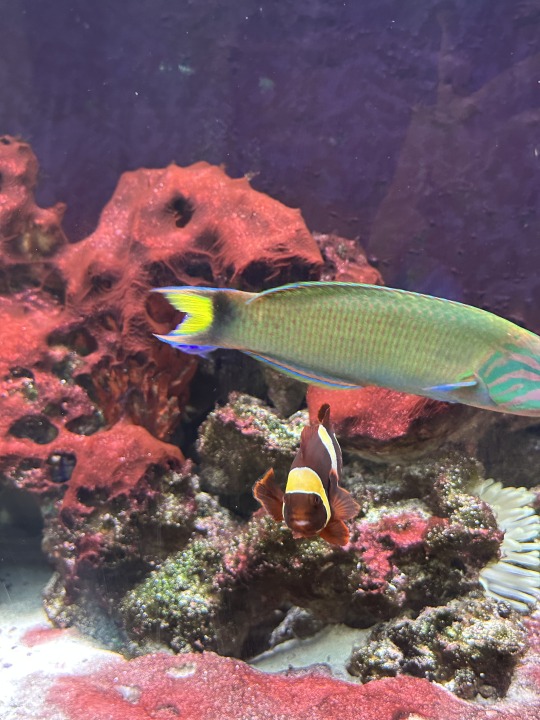
View On WordPress
#Aquarium#cleaning of fish tank#damsel fish#fish tank#red algae#Red algae in fish tank#trigger fish#tropical fish#wrasse
1 note
·
View note
Text


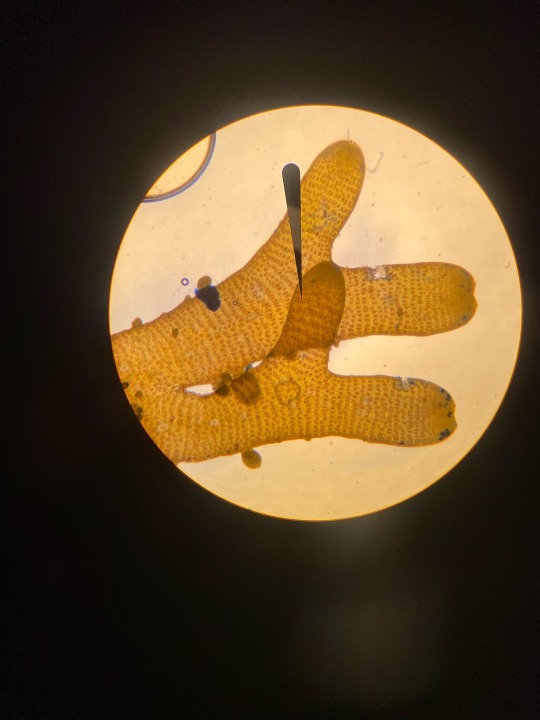
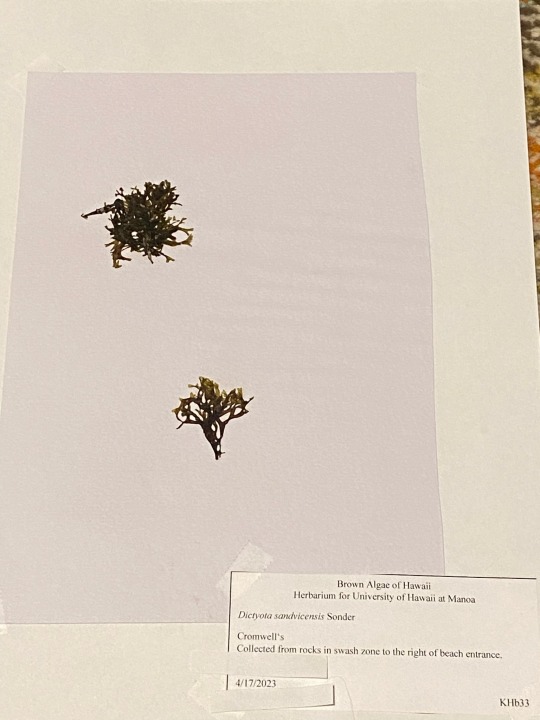
#marine life#marine biology#phycology#limu hoard#herbarium daily#herbarium#digital herbarium#dictyota#dictyota sandvicensis#tropical algae#brown algae
25 notes
·
View notes
Text
last list of "beautiful" words for 2024
to try to include in your next poem/story
Asterismal - of or relating to asterisms or constellations
Astichous - in botany, not arranged in rows
Astroite - a radiated or star-shaped mineral or fossil
Bloodflower - a tropical herb (Asclepias curassavica) with orange-red flowers
Diapasm - perfume of powdered aromatic herbs sometimes made into little balls and strung together
Diapason - a burst of sound
Diarize - to keep or write in a diary
Diatomin - a yellow or yellowish brown pigment found in certain algae and diatoms
Equant - of, being, or relating to a crystal having equal or nearly equal diameters in all directions
Gradine - one of a series of low steps or seats raised one above another; a shelf at the back of an altar on which candlesticks and flowers are placed in a Christian church
Intervert - to turn to a course or use other than the proper one; misuse
Kippage - an excited or irritated state; commotion, confusion
Kithe - to make known
Notionate - fanciful, notional; headstrong, stubborn
Perimorph - a crystal of one species enclosing one of another species
Peripeteia - a sudden or unexpected reversal of circumstances or situation especially in a literary work
Quaesitum - something sought for; end, objective
Rounceval - something very large; huge
Senecio - any of a large genus (Senecio) of widely distributed composite plants that have alternate or basal leaves and flower heads usually with yellow ray flowers
Senectitude - the final stage of the normal lifespan
Tragedienne - an actress who plays tragic roles
Urceolate - shaped like an urn
Urostege - a scale on the underside of the tail of a snake
Urushiye - a Japanese color print in which the dark colors are printed with a lustrous medium commonly considered to be lacquer
Windflaw - a gust of wind; flaw
If any of these words make their way into your next poem/story, please tag me, or send me a link. I would love to read them—always.
More: Lists of Beautiful Words ⚜ Word Lists ⚜ Writing Resources PDFs
#beautiful words#writeblr#spilled ink#dark academia#linguistics#langblr#studyblr#writers on tumblr#writing prompt#poetry#poets on tumblr#literature#lit#word list#creative writing#fiction#writing reference#light academia#writing resources#thank you for making this blog's first year quite lovely -- here's to more lists of beautiful words for 2025 <3
381 notes
·
View notes
Text
The corys getting a good nom on some frozen brine shrimp~
#aquablr#fishblr#petblr#siamese algae eater#peppered corydoras#albino corydoras#cory cat#corydoras#cory catfish#planted aquarium#aquarium#freshwater aquarium#fish#tropical fish
28 notes
·
View notes
Text
Wet Beast Wednesday: Christmas tree worm
Merry Christmas from the ocean! For this festive occasion, I’ve chosen to cover an animal that certainly has the spirit of the season. The Christmas tree worm is the person who keeps their Christmas lights up all year of the sea and today we’re going to see what makes them tick.
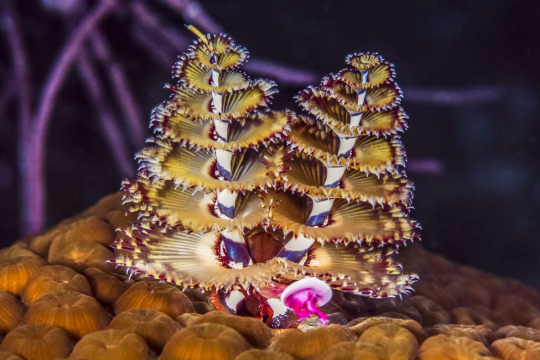
(Image: the crown of a Christmas tree worm. It appears as two stalks emerging from amongst coral polyps. Small feathery, appendages emerge from the stalks in a spiral formation going up them. They are yellow, with brown tips. A smaller, round structure is near the base of the trees. End ID)
The Christmas tree worm (Spirobranchus giganteus) is a polychaete worm of the tube-building fan worm clade Sabellida. While they are called giganteus, that’s only relative to other fan worms as they max out at about 3.8 cm (1.5 in) long. Being tube worms, they build a tube of calcium carbonate that they live in. This tube provides protection for the worm, who can retreat into it if threatened by predators. Polychaetes are defined by the paired bristle-like chaetes on each body segment, which are often used for locomotion. Tube worms like the Christmas tree worm lack these kind of locomotive appendages as they spend their entire lives in their tubes.

I couldn't find a full-body picture of a Christmas tree worm outside of its tube, so this is the best you get. (Image: Serpula vermicularis, a member of the same family of tube worms as the Christmas tree worm, removed from its tube. It is a short, segmented worm with a plug on a stalk and a crown consisting of long, feathery tentacles arranged differently than those of a Christmas tree worm. End ID)
The feature that gives these worms their common name is a pair of feathery, spiraling structures that emerge from the head and look quite a bit like tiny, colorful fir trees. These structures, called crowns, are heavily modified version of mouth appendages called prostomial palps. The feathery bits are tentacles called radioles. The crown is usually the only part of the worm visible, with the rest of its body safely in the tube. The crown is used both for feeding and respiration, as it can perform gas exchange with the water like gills. Christmas tree worms, like other fan worms, are filter feeders. They expose their crows to the water and wait for edible plankton and bits or organic detritus to get caught by the radioles. Cilia then transports the food down to the mouth. Christmas tree worms have a modified radiole called an operculum that acts like a lid to the front of the tube, closing it off when the worm retreats. The crown also has light-sensing structures, allowing it to detect light and shadow. The visual capabilities of these eye spots is poorly studied. The crown makes up about a third of the body length and can come in a wide variety of colors. It can regenerate if damaged.
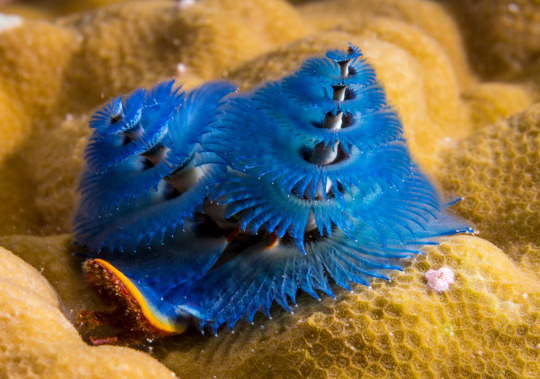
(Image: a blue-crowned Christmas tree worm emerging from yellow coral. End ID)
Christmas tree worms are found across most of the world, from the Caribbean to the Indo-Pacific, in tropical waters. They are coral reef dwellers who live in burrows built into had corals. Brain coral species are their preferred hosts, but they can live on other corals and have been reported living in sponges and on giant clams. Christmas tree worms certainly have a symbiotic relationship with the corals, it's debatable whether that relationship is parasitic, commensal, or mutualistic. They may damage nearby polyps and could spread harmful algae (that seems to be an open question), but I found sources suggesting they improve water flow around the coral, which could benefit it. When they sense a threat, the worms will rapidly retract into their tubes. Some time later (which can be seconds to minutes), they will cautiously emerge again. Worms living on crowded corals seem to be more timid, taking longer to emerge again. Christmas tree worms are broadcast spawners who release their gametes into the water. Fertilized eggs hatch quickly into larvae who must find their way to a coral and start their burrow. Christmas tree worms can live up to 30 years.
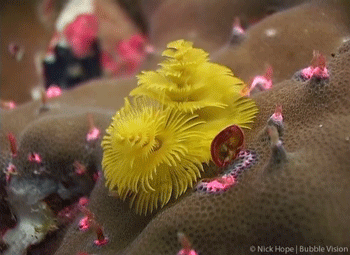
(GIF: a bright yellow Christmas tree worm retracting into its tube. The full retraction takes less than a second and leaves only a hole covered by the operculum. End ID)
Christmas tree worms are considered to have a stable population, but as they are dependent on corals, threats to reefs are threats to them. Thus, global climate change is a major threat to their survival. Predators of the worms include fish, starfish, and other worms. They are not of commercial interest to humans, but are popular among divers and have entered the aquarium trade.

(Image: multiple Christmas tree worms of various colors emerging from a coral. End ID)
#wet beast wednesday#christmas tree worm#wormblr#worms#worm#polychaete#annelid#invertebrates#invertiblr#coral reef#christmas#christmas tree#marine biology#biology#ecology#zoology#animal facts#informative#educational#image described
255 notes
·
View notes
Text



The Smouldering Smoky Jungle Frog
The smoky jungle frog (Leptodactylus pentadactylus), or huwa in the native Brazilian Kwaza language, is a species of frog found throughout the Amazon rainforest, and as far north as the cloud forests of Costa Rica. They are found primarily in tropical rainforests, as well as marshes, artificial ponds, and near rivers. Despite their penchant for moisture, they spend most of their time hiding among leaf litter on the forest floor.
The huwa frog's shape and coloration allows them to blend seamlessly into the leaf litter of their natural habitat. Adults are mottled brown, grey, black, red, and orange, mimicking the coloration of fallen leaves, while the underside is white. Adults also have two ridges extending down either side of the back which imitates the shape of a discarded leaf. Males are slightly larger than females, with a maximum length of 18.0 cm (7.1 in) compared to 17.6 cm (6.9 in); adults can weigh anywhere from 60-70 grams (0.15 lbs).
L. pentacactylus is active mainly at night, when they emerge to feed on insects, small birds, frogs, snakes, lizards and mammals such as bats and rodents. Their camouflage allows them to blend in with the leaf litter and wait to ambush passing prey. They can also effectively hide from predators such as larger snakes, caimans, and coatis. In addition to their invisibility, adults also secrete a mild toxin from their skin which can irritate the eyes and cause an itchy rash.
Outside the breeding season, smoky jungle frogs are largely solitary. Males defend their territories by loudly calling throughout the night; from May to November these calls also serve to attract females. After mating, females dig a shallow depression in the ground and construct a nest from foam made of discarded sperm, water, and air. Up to 1,000 eggs are deposited in the nest. Eggs hatch only 2-3 days after being laid, and the frequent rains wash the tadpoles into a near by pond or slow-moving stream. The tadpoles feed voraciously on vegetation, algae, and insects, and within four weeks metamorphose into adults. Once fully grown, individuals can live up to 15 years in the wild.
Conservation status: Smoky jungle frogs are considered Least Concern by the IUCN. Their primary threat is habitat loss.
Photos
Marco Aurelio de Sena
Geoff Gallice
David Torres
#smoky jungle frog#Anura#Leptodactylidae#ditch frogs#white-lipped frogs#southern frogs#frogs#amphibians#tropical forests#tropical forest amphibians#tropical rainforests#tropical rainforest amphibians#south america#northern south america#amazon rainforest#central america#animal facts#biology#zoology#ecology
130 notes
·
View notes